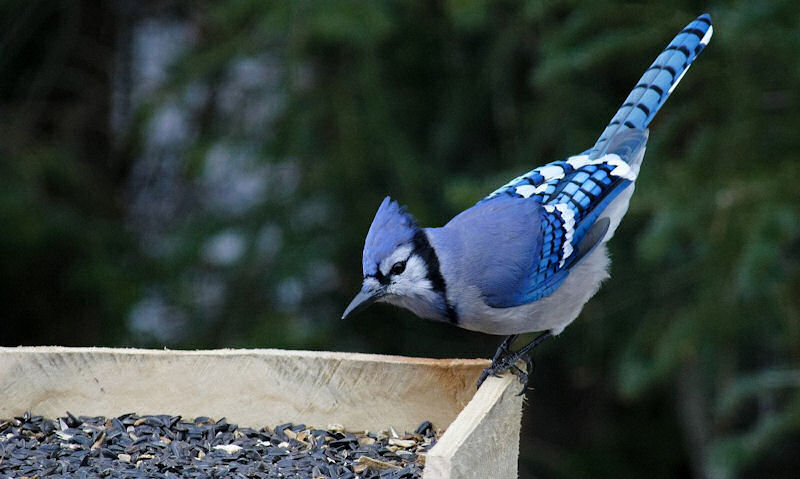How to attract Blue Jays to a bird feeder
Big bird that is incompatible with most common bird feeders, with the only way to feed Blue Jays their favorite bird feed is out in the open, preferably on a platform feeder.
How to attract Blue Jays to a feeder is with an open to the elements platform bird feeder on a pole, if it hangs or better still, is a ground bird feeder for this ground eating bird. Blue Jays will eat many things in the wild with your options being peanuts in or out of shells, seed mixes and dried or live mealworms.
How you'd attract Blue Jays to bird feeders is to understand how they forage in nature, with the ground, trees and shrubs making up their area to forage in.
As quite a large bird, Blue Jays are less likely to feed on a restricting, hanging bird feeder for seeds or nuts, when this kind of bird food would be better off placed on top of an open platform bird feeder.
Bonus being all regular bird feeder food can be added on top of it, with no other choice if using fruits or mealworms. With the nuts you can offer peanuts in shells in which Jays like at lot, with hard seeds cracked open right on top of the platform.
Make it an open to the elements platform bird feeder on a pole with an option for one on the ground... or if it hangs it must remain accessible.
Remember Blue Jays can be scrappy at times, thus will keep other birds away. If there's any sign if this, a platform bird feeder setup for Blue Jays can stop them being a nuisance to shyer, more timid birds such as Titmice as other feeders.
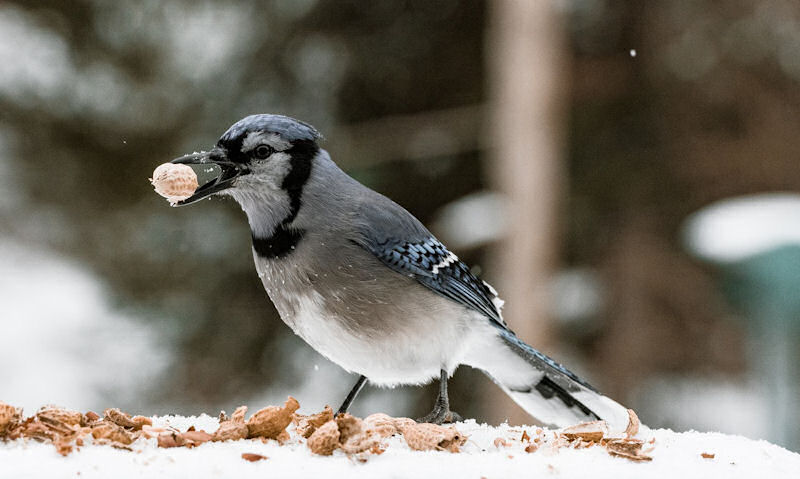
Bird feed what they eat in the wild can be replaced with specialty bird food: including dried or live mealworms, sunflower seeds or seed mixes, or peanuts in or out of their shell.
Once in a while some people will be forced to attract birds to a feeder by actually encouraging Blue Jays out of the bird feeder, if that makes sense.
You see a bird feeder can be restricting or unseen to Jays, whereas where they forage on the ground or within shrubs - its here where bird feed can be thrown. In the meantime Blue Jays will hopefully be seen to eventually use the accessible feeders in the yard.
Display favorites as seen in air
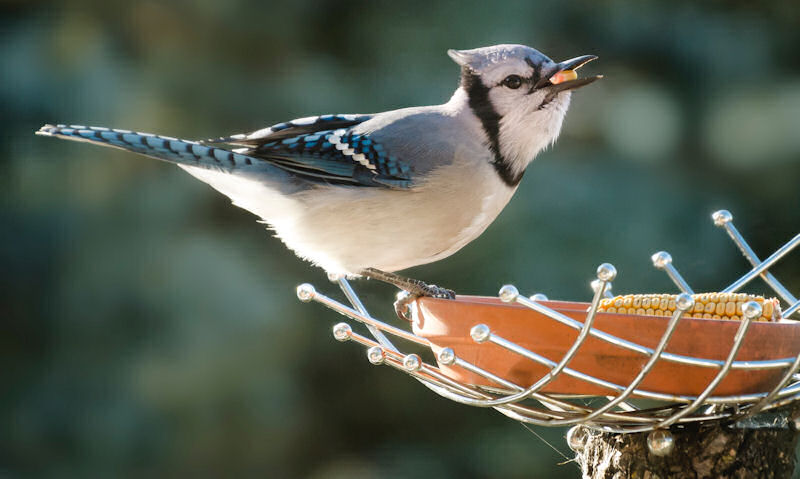
As a fairly large common backyard bird, the Blue Jay isn't the most capable of birds at bird feeders, thus an open to the elements bird feeder must be used.
What kind of bird feeder you can use is an open top platform bird feeder on a pole, or an equally accessible platform ground feeder - with an option for a platform that hangs.
How this will attract Blue Jays is the open to the elements platform can display all their favorite bird food, in a way that is sure to grab their attention while in the yard - or if any Blue Jays happens to pass over above.
Display Blue Jays favorite bird food to be seen in the air, in which will include peanuts or offer up whole peanuts in shells; in which is a Blue Jays favorite way of eating them, or at least they will store them up for the winter.
What you can feed Blue Jays in this kind of bird feeder is anything you can imagine; add nuts of course, seeds with sunflower seeds liked the most, dried or live mealworms, grain such as oats, berries and small fruits.
Classic nut or seed mix bird feeders of the clear window tube feeders kind tend to be incompatible with Blue Jays, as a big bird like this is unable to perch on such a small, unstable bird feeder.
You'd then have to use the open platform bird feeder, with the exception of using a seed feeder with a wide seed tray on the base - or why not a peanut feeder with an extended perch wedged into it.
Pop feed out of feeder
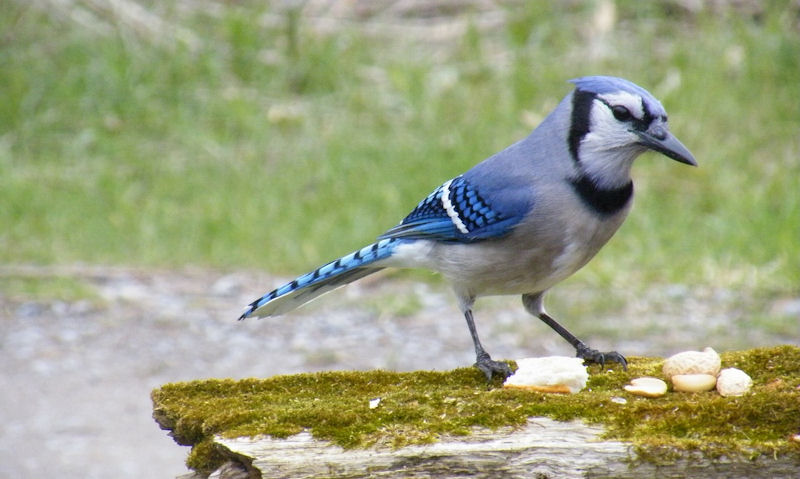
You know what, as Blue Jays are ground feeding birds at heart, let's make life easy on them by offering all kinds of bird feed on the ground.
Larger than life birds like Blue Jays are not compatible with the complexity of a restricting bird feeder; thus to offer bird feed on the ground can open up all opportunities, with potentially more Jays following behind.
Now that isn't to say you must throw bird seed mixes or nuts over the ground, when a ground bird feeder is just what you need be sure bird feed lasts longer.
Once again you'll have to replicate the kind of food Blue Jays eat in the wild, which can include insects, nuts, seeds, berries and small fruits.
Not a problem as peanuts in or out of the shell can be offered to Blue Jays, whereas their favorite sunflower seeds can replace their random seed mixes they eat in the wild.
Similarly to live insects foraged for in the wild can be replaced with readily available live mealworms - though dried mealworms are just as popular, yet less yucky for most people to handle.
Blue Jays can eat all this at feeders with the bonus of open to the elements' feeders made accessible with mealworms or fruits - whereas a standard hanging bird feeder isn't made compatible with fruit at all.
Layout vibrant colors
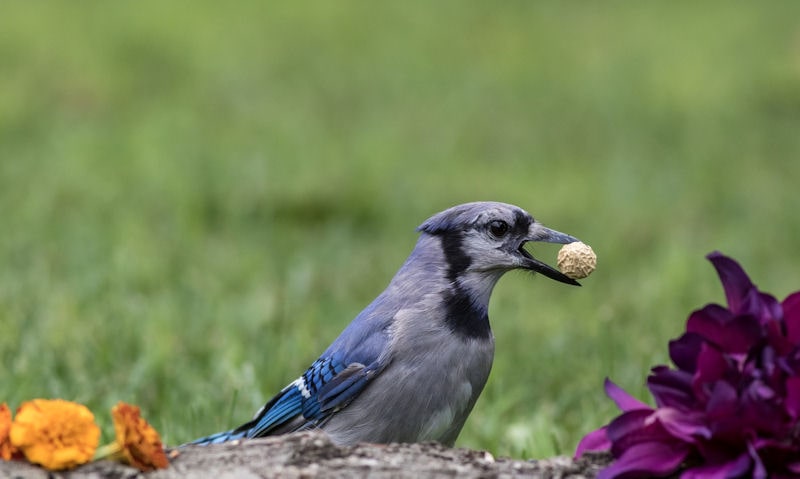
Despite popular belief, Blue Jays are not attracted to the color blue, because that is what Blue Jays are.
In fact Blue Jays can be attracted to vibrant colors of any shade, providing its bright and stands out against a duller contrasting background.
What kind of bird seed mixes you offer Blue Jays will provide some attracting colors, with Blue Jays landing to investigate this attractive yet abundance of seed mixes.
Where bird feed can be a little bland in color, placing bird feed by colorful flowers or indeed on top of brightly painted wooden platform bird feeders can help.
Blue Jays are sure to visit your backyard from time to time, thus this will be a good time to grab their attention with bird feed laid out - thus the mix of bright colors will be unnecessary after all.
Jays know what a bird feeder looks like and therefore can work out there's bird feed contained within.
Concentrate your efforts on bright bird feeders if you can, even if its a bird feeder with a speck of vibrant colors - then Blue Jays will be sure to be attracted to the bird feeder come rain or shine.
Fountain bird bath noise
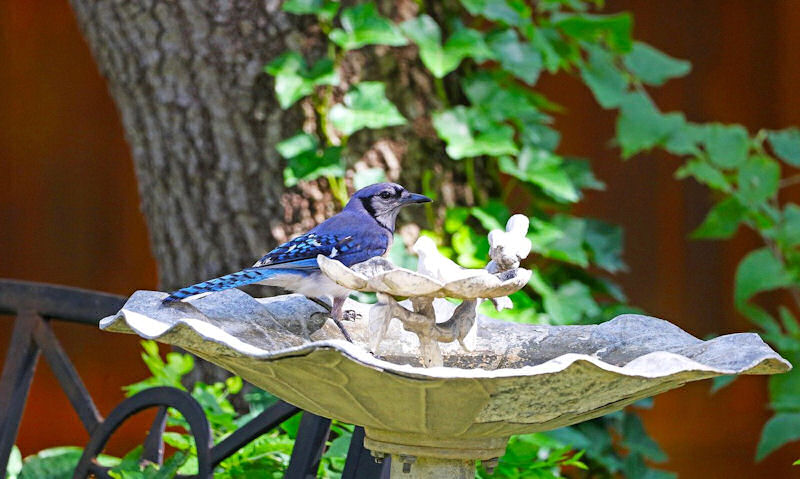
How you'd attract Blue Jays to a bird feeder is of course with accessible bird feeders in mind, along with their favorite bird feed fully available on top, sitting out in all weather.
While Blue Jays are unable sniff out bird feed, they can see if up close in the yard or if they soar way above in the sky.
However what you don't get out of a bird feeder what you can get in a bird bath, is sound.
Blue Jays can be attracted to the sound of running water, thus a solar powered fountain bird bath is sure to bring Blue Jays, among many others to the bird bath to hydrate or preen their feathers.
Of course you want to attract Blue Jays to feeders, though a bird bath is only the start.
Once Blue Jays have been drawn to a bird bath with the sound of water, what is stopping them then hopping over to your bird feeders now and potentially for the foreseeable future.
You only need to attract Blue Jays to the sound of water or if the glistening of water is seen in the air - then birds such as Blue Jays will proceed to take full advantage of any food sources in your yard.
While your at it, you can even pop some seeds, peanuts or dried mealworms on the rim of the bird bath, to get things going on a positive note.
Assure Blue Jays come back
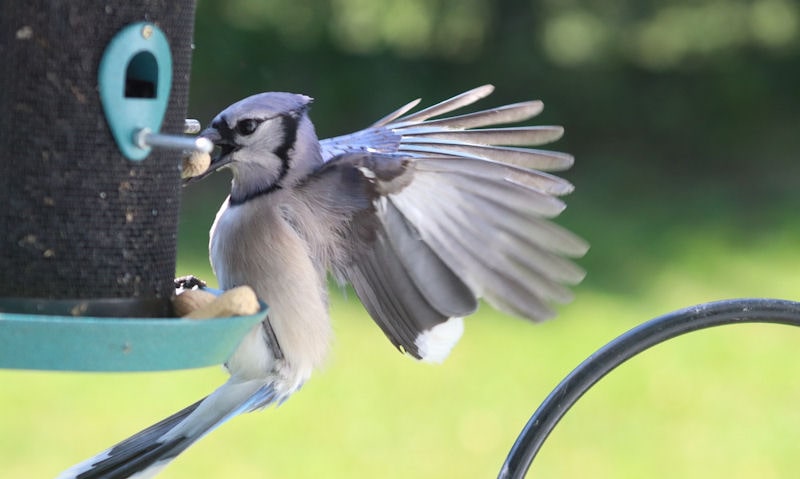
Now that you've done all you can to attract birds to your yard, and therefore proceeded to use your bird feeders, let's keep things going for years to come.
Never stop feeding Blue Jays the way you have done so previously in order to attract Jay in the first place - in the last few weeks or months... to then bring it all to a pause.
Blue Jays will go away if their favorite bird feed dries up in bird feeders, as they seek new feeding grounds at your neighbors or in the wild.
Assure Blue Jays come back by continuing to commit to a strict rule of feeding birds once or twice a week. Continue to offer them their favorite seeds, peanuts, suet or dried mealworms on top of feeders - as well as on the ground so it remains accessible.
I will say to keep Blue Jays away from bird feeders is to offer them up their own unobstructed bird feeder - in which can keep them well away from feeders reserved for smaller, often less aggressive backyard birds.
Along with an open to the elements platform bird feeder on a pole, one that hangs or is a ground bird feeders; a bird bath can continue to be used to allow thirty Blue Jays to re-hydrate and preen their feathers in times of drought or if experiencing a heatwave.
What is more important than anything else to see Blue Jays return daily, is a healthy supply of their favorite peanuts, sunflower seeds and live or dried mealworms.
Conclusion
How you will attract Blue Jays to a bird feeder is first to provide an accessible feeder to what would otherwise be a too small, incompatible feeder for larger backyard birds.
I will then run with an open top platform bird feeder on a pole, or one that is a ground platform bird feeder - seeing as Blue Jays are officially ground eating birds.
Hanging platform bird feeders with an option for Jays to perch around the rim must be used, whereas a tube seed feeder must provide a long perch or a seed tray surround to allow Blue Jays to perch with ease.
And then there is what to feed Blue Jays in your yard, with priority being feeding them close to what they eat in the wild.
What Blue Jays eat most of the time is nuts, seed mixes, insects, berries and fruits. Now Jays do eat many other things in the wild including animals of sorts - though in the meantime let's concentrate what to offer Blue Jays in a bird feeder.
Blue Jays will eat nuts in nature thus peanuts in or out of the shell can be offered.
They will eat all kinds of seeds in the wild whereas you can offer them seed mixes on top of the platform bird feeder - with a priority on their favorite sunflower seeds.
As Blue Jays eat many insects while foraging on the ground, you can replace this much needed protein source with dried mealworms... or get their attention with wiggly live mealworms thrown over the lawn.
As a ground eating bird in the wild, it may be best to feed Blue Jays on the ground at first, then hopefully they proceed to use accessible bird feeders a little later.
To fortify your efforts after all this time, Blue Jays still need a place to drink or preen their feathers, thus a bird bath can be setup near by. Why not go the extra mile by adding a fountain feature operated by solar power, to get Jays attention with the sound of water.
